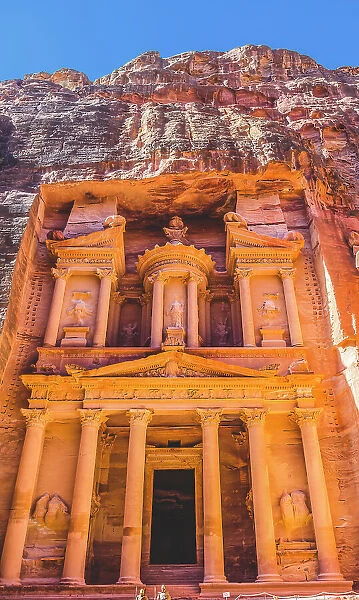The ancient city of Petra, known for its stunning rock-cut architecture and iconic appearance in the movie Indiana Jones and the Last Crusade, has long been a treasure trove of archaeological wonder. Recently, a significant discovery has further deepened the intrigue surrounding this legendary site—a secret tomb was found hidden beneath the very location where Indiana Jones was filmed. This remarkable find sheds light on Petra’s rich history, connecting it to its Nabataean past, and has sparked excitement among archaeologists and historians alike. With the tomb's discovery, the exploration of Petra’s secrets continues, drawing modern-day explorers and enthusiasts into a real-life adventure. Follow us here at serious allegations against Kanye West.
The Ancient City of Petra
The ancient city of Petra, located in modern-day Jordan, has been a UNESCO World Heritage site since 1985, but its allure has been well-known for centuries. Often referred to as the “Rose City” due to the red-hued sandstone cliffs, Petra is an architectural wonder carved directly into the mountains. Its strategic location along ancient trade routes made it a vital center for commerce, culture, and religion in the Middle East. The Nabataeans established the city, an ancient Arab civilization that flourished in the region from the 4th century BC until their eventual annexation by the Roman Empire in AD 106.

Petra’s most iconic structure, Al-Khazneh, also known as “The Treasury,” is a massive temple carved into the rock face. It gained global fame after featuring in Indiana Jones and the Last Crusade as the hidden temple that housed the Holy Grail. Since the film’s release, Petra has attracted millions of visitors drawn to the site for its beauty, history, and the sense of adventure that the film helped to popularize.
Dr. Pearce Paul Creasman
The discovery of the secret tomb was made by Dr. Pearce Paul Creasman, a renowned archaeologist and Egyptologist with a deep interest in the ancient Near East. Dr. Creasman has dedicated his career to unearthing the mysteries of the ancient world, with a particular focus on understanding the cultural and historical significance of sites like Petra. His expertise, combined with advanced excavation techniques, led to the uncovering of the tomb beneath Petra's famous Treasury.

Dr. Creasman’s excavation was part of a broader initiative to re-examine areas of Petra that had long been thoughtfully explored. Using modern ground-penetrating radar and digital mapping, his team discovered anomalies beneath the rock surface, which eventually led them to the hidden tomb. This find is being hailed as one of the most significant in recent years, offering new insights into Petra's history and the people who once called it home.
The Nabataeans
The Nabataeans were ancient Arab people who established Petra as their capital and transformed it into a flourishing center of trade. They were master architects, and their ability to carve monumental structures into the cliffs of Petra remains one of their most remarkable achievements. The Nabataeans controlled vital trade routes that linked the Arabian Peninsula with the Mediterranean, Egypt, and beyond, which allowed them to amass great wealth.
The newly discovered tomb is believed to belong to an elite member of Nabataean society, possibly a royal or high-ranking official. While the exact identity of the individual buried there remains a mystery, the tomb's elaborate construction, and hidden location suggest that this person held significant power and influence within the Nabataean kingdom. The artifacts and inscriptions found within the tomb are currently being studied, and they may reveal more about the Nabataeans' political and cultural life, as well as their religious practices.
Petra’s Ongoing Archaeological Significance
Petra continues to be a focal point of archaeological research, and the discovery of the secret tomb has reinvigorated interest in the site. The excavation is part of a growing trend in archaeology that utilizes cutting-edge technology to re-examine ancient sites and uncover new information. Techniques such as ground-penetrating radar, 3D scanning, and drone surveillance have allowed archaeologists to explore previously inaccessible areas of Petra, leading to discoveries like this secret tomb.
In addition to its archaeological importance, Petra remains a major tourist destination, attracting visitors from all over the world who are eager to walk in the footsteps of ancient civilizations—and, of course, Indiana Jones. Tourism plays a vital role in Jordan’s economy, and efforts are being made to balance preservation with public access, ensuring that the site’s historical integrity is maintained for future generations.
Unraveling More Secrets of Petra
The discovery of the secret tomb beneath Petra’s Treasury opens the door to further exploration and potential discoveries in the ancient city. The tomb’s hidden location raises the tantalizing possibility that there may be other undiscovered chambers or artifacts lurking beneath Petra's well-trodden paths. Archaeologists, including Dr. Creasman’s team, are optimistic that continued excavation will lead to more findings that could reshape our understanding of the Nabataean civilization.
Moreover, as technology continues to advance, archaeologists are hopeful that they will be able to delve deeper into Petra’s uncharted areas without causing damage to the site. This combination of innovation and preservation will be key to unlocking Petra’s remaining mysteries, as well as safeguarding the city for future generations to explore and admire.
In the coming years, Petra’s role as a symbol of both ancient history and modern discovery will likely only grow stronger. With the new tomb serving as a focal point for research, scholars and explorers alike are eagerly awaiting what other secrets this fabled city may reveal. The continued exploration of Petra will undoubtedly contribute to our broader understanding of the ancient world and the civilizations that once thrived in it.